Document Settings
5 min read
last updated: 02/05/2024
Before describing the document properties, lets go through the internals of the ReqIF files.
TLDR jump to Document properties
Attribute types
Each specification document has its own set of attribute types that are used as attributes. The list can be displayed using the menu Settings > Document.
Automatic data types for documents
Each new document will have: integer, real, date, string, xhtml and boolean attribute types automatically created, which can be edited.
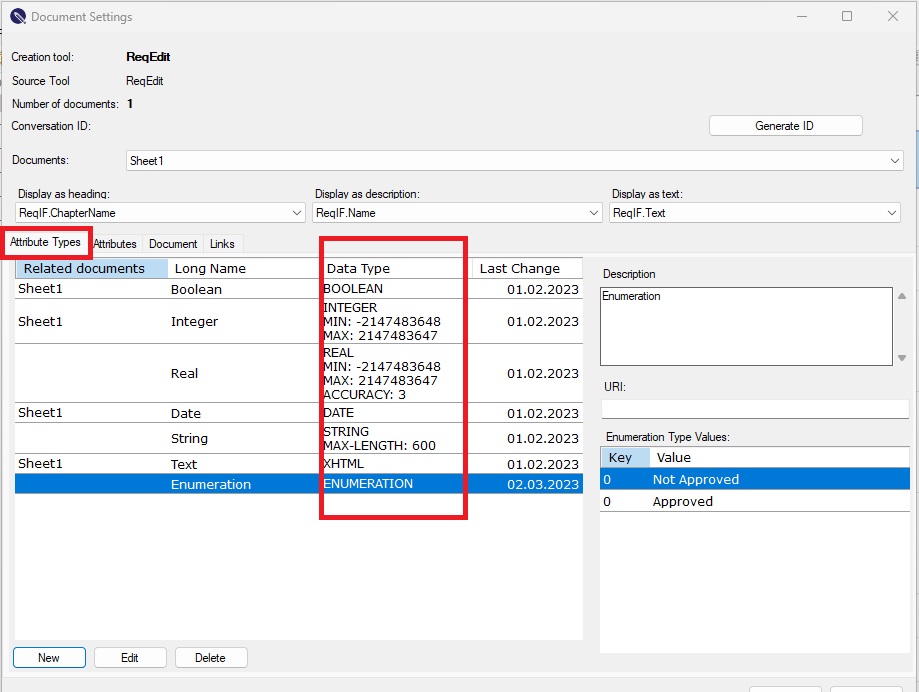
Data types
Attributes in ReqIF files are constructed from underlaying data types with or without restrictions. The usage of restrictions in the data types can make the requirement specifications more robust by not letting invalid values to be used.
Properties of data types
Depending on data types, different properties are available. The following table describes all available properties per data type
| Long Name | Description | Min | Max | Accuracy | Enum Values | |
| Boolean | X | X | ||||
| Date | X | X | ||||
| Enumeration | X | X | X | |||
| Integer | X | X | X | X | ||
| Real | X | X | X | X | X | |
| String | X | X | X | |||
| XHTML | X | X |
Boolean
Its value can be true of false. These two states are displayed by a check box on the screen. This is an exception type, double click on the cell is not necessary for editing. Its value can be altered by a single click.
Date
A real date can be written or set as its value. In the view mode, the cell shows the value of the date, but in the edit mode it displays the DateTimePicker controller used for selecting the date. This offers help for the user to select fast the exact date. The date value can also be removed by unchecking the box in the top left corner of the date picker.
Integer
An integer can be given as a value between previously determined limits. In case of not giving a numeric type, the program will display an alert and the user can only continue if a correct value is entered.
Real
The value can be a decimal number between previously determined limits. In case of not entering a numeric type, the program will display an alert and the user can only continue if a correct value is entered.
String
An unformatted text with a previously determined length can be entered as a value.
NOTE: The maximum allowed length of a string is 600 characters. This limitation was imposed in order for the files to be compatible with IBM Rational DOORS.
Enumeration
Represents a list of fixed values that can be used.
Each value has a Numeric Value, a Label displayed to the user, and an optional color in HEX or named color.
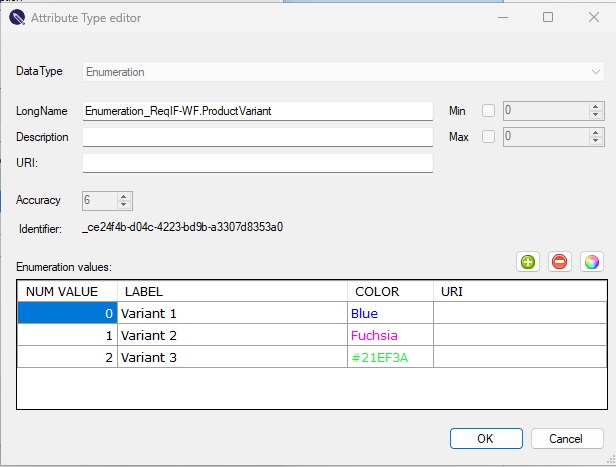
XHTML
XHTML format permits formatting of text in multiple ways, similar to any text processing application: Bold, Italic, Underline, Strikethrough, Superscript, Subscript, Unordered list, Ordered list, Paragraph, Normal text, Heading 1 – Heading 6
In addition to text formatting tables and images can be used in the content, as well as file attachments.
URI
The URI Represents the Resource types defined by DNG data models. All the attribute definitions, attributes, enum values may have URI values defined.
Attributes
Using the defined attribute types, attributes can be created to be used in the document or the objects. Each data type has its own properties shown in the following table
| Long Name | Description | Read Only | Multivalued | Default Value | |
| Boolean | X | X | X | X | |
| Date | X | X | X | X | |
| Enumeration | X | X | X | X | X |
| Integer | X | X | X | X | |
| Real | X | X | X | X | |
| String | X | X | X | X | |
| XHTML | X | X | X | X |
Enumeration attributes
Using enumeration data types in attributes has two main use cases
Single-value enumeration
You can choose only one value from a previously determined value set. It shows the chosen value in cell viewer mode. In the editor mode you can choose the required value from a values list (ComboBox or DropDownList).
Besides the values of an enumeration attribute type, the user can also select the value to remove the value of a cell.
Multivalue enumeration
You can choose multiple values from a previously determined value set. It shows the chosen value in cell viewer mode. In the editor mode you can choose the required values from a list by selecting each check box.
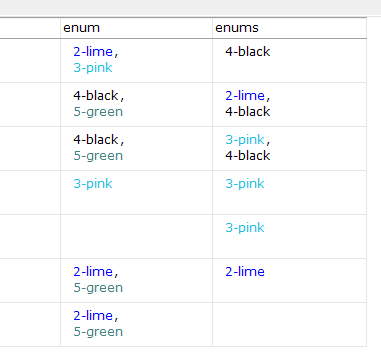
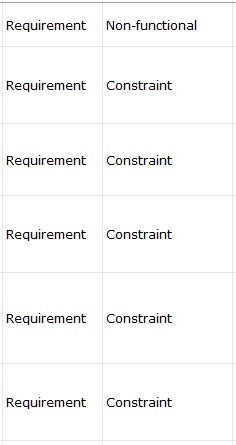
Document Properties
Information related to a specification document is visible in the Document tab. Document Name, description, attributes and statistics.
Statistic Information of:
- Documents in file
- Rows in selected document
- Attributes in selected document
- Attribute types in selected document
- Incoming and outgoing links
Attributes that are defined internal to the specification are also listed with the value displayed on the right side.
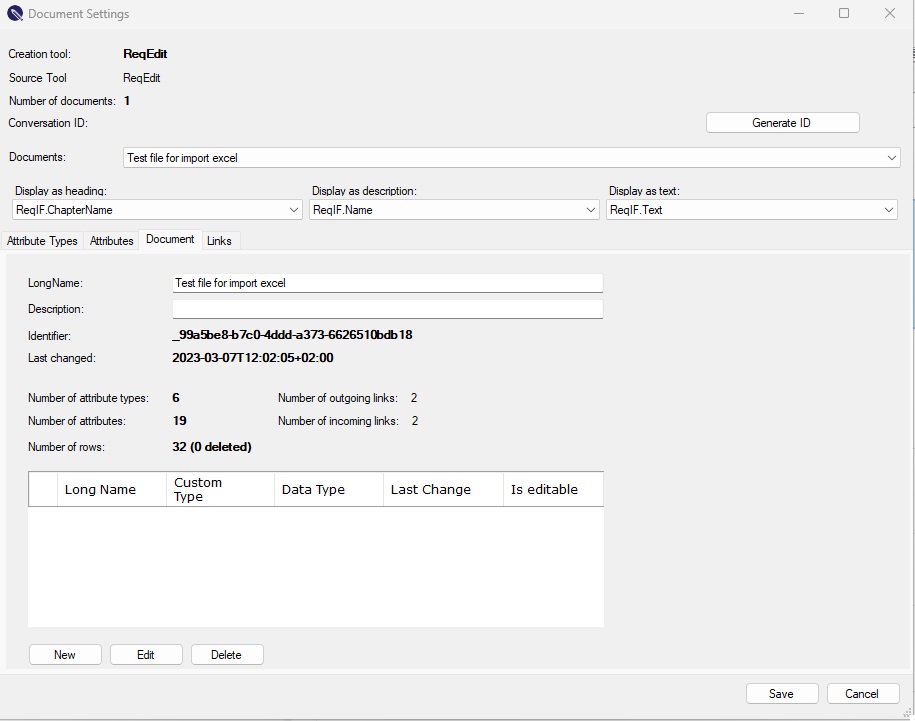
Main Column (heading and text) supports STRING and XHTML as attribute type.
Specification types
Currently not displayed, internally will be created and used exactly as in the ReqIF standard.
Object Attributes
List of attributes used in all objects of the selected document.
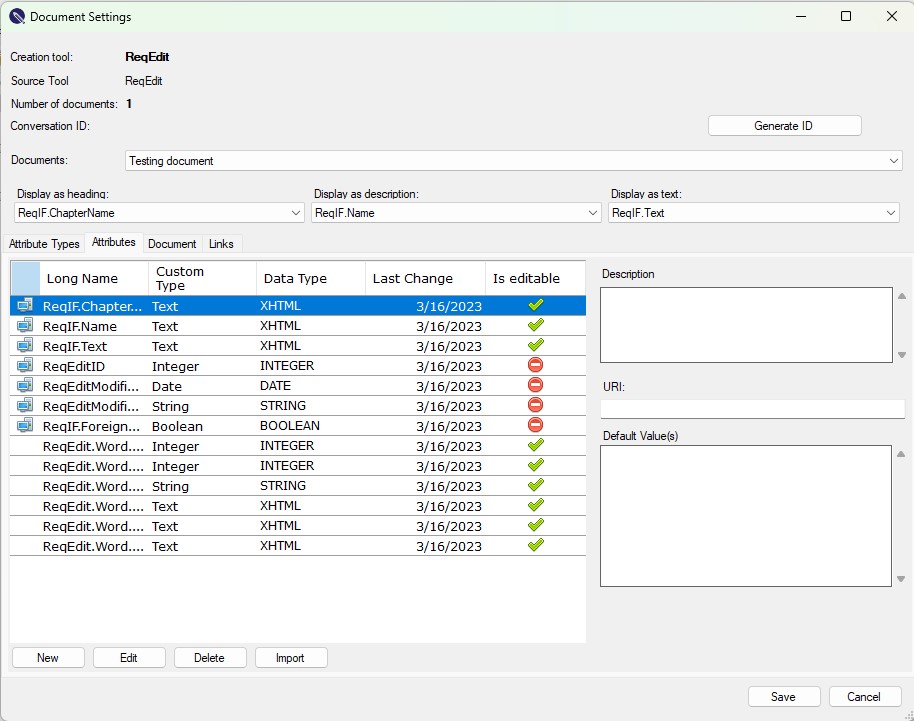
System attributes are displayed by a PC icon in the list, these attributes cannot be deleted
ReqEdit internal attributes
- ReqEditID – integer type, read-only attribute, internal unique ID
- ReqEditModifiedOn – date type, read-only attribute, last modification date of the object
- ReqEditModifiedBy – string type, read-only attribute, stores the Windows username who edited the object
Import attributes from other file
To import attributes from an other file:
- Open both files
- Click on Document settings\ Attribute tab\ Import
- Select source ReqIF
- Select the attributes to be imported
- Click Save
In case of Attrybute type – enumeration,
- If enumeration attribute exist – after importing, the new values will be added to the enumeration.
- if attribute already exist and type is not the same – the old attribute will be renamed to “… OLD” and does nothing to it
SpecObject types
Currently not displayed, internally will be created and used exactly as in the ReqIF standard.
Links
Are covered in the Links chapter